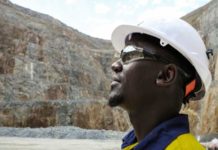
[miningmx.com] — FOR a whole decade, there has been 6.25 million tonnes (mt) of top-quality iron ore available to promote steel manufacturing in SA.
Despite that, Iscor’s privatisation yielded only disappointing results for SA steel consumers. This was because ArcelorMittal South Africa (Amsa), to whom this valuable asset was entrusted, made sure that it and its shareholders reaped the biggest reward from this resource.
Kumba – which took over Iscor’s valuable Sishen mine after the unbundling of Iscor – was for years contractually bound to supply the 6.25mt to Amsa at cost plus 3% (which is essentially the real cost price, because the 3% represents non-mining expenses).
It’s therefore no surprise that Kumba this week voiced its opposition to the new government plan to allow the availability of cheap iron ore to lead to a steel price that will boost steel manufacturers.
Since the expiry of Amsa’s mineral rights in Sishen and Kumba’s termination of the profit-neutral supplying contract with Amsa, a lot of thought has been given to how these 6.25mt of iron ore can translate to cheaper steel prices.
The arguments proposed on behalf of Kumba this week by international consultant Robert Stillman against the plan to try to influence the domestic steel market have been put forward for years by Amsa, whenever there was any opposition against Amsa’s price policy in SA.
According to Stillman, lower-priced steel will not necessarily lead to significant growth and job creation in the country’s manufacturing sector – “not even if steel producers get their ore free’.
This is because steel makes up only a small fraction of steel consumers’ total costs.
Also, Amsa is the only company that produces steel from iron ore. The other, smaller steel producers, Evraz Highveld, Scaw Metals, Cisco and Diferco, produce steel from waste.
Stillman feels SA can create more jobs by helping more producers become established so that they can export iron ore.
The country is competitive in this market, while its export opportunities for steel are limited. The landed cost of SA steel is about 30% higher on the international market than the world’s cheapest producers, he says.
In addition, about 85% of the approximately 4.4mt consumed in SA is used in industries where steel represents less than 5% of the input cost.
Of course, this is probably due to SA steel being so expensive after Iscor’s privatisation that industries which need large quantities of steel, like machinery and equipment manufacturing, aren’t viable here.
Stillman emphasises that more competitive steel prices would not be “a bad thing’, but that one can expect fairly limited growth to result from this.
In other countries, he says, a 10% drop in steel prices resulted in growth of between 2% and 3% in steel-related manufacturing.
Before the privatisation of Iscor, steel prices were simply adjusted in line with the inflation rate every year. After ArcelorMittal took over Iscor, prices sometimes rose by more than 50% per year.
Stillman also puts forward another argument: steel prices in SA are not competitive because Amsa has “market power’. In other words, Amsa has a virtual monopoly in SA’s steel market.
More competition, perhaps a second steel producer, would force Amsa to lower its prices nearer to export parity – the price at which Amsa exports steel.
Kumba and Assmang, the only other major iron-ore producer, have done in-depth research on the viability of a second large steel producer. They couldn’t find any commercial rationale in favour of it.
Steel Authority of India and Lazarus Zim are planning to establish a second steel plant in SA, but Stillman has reservations about this too. A second steel plant that makes commercial sense cannot be set up without considerable state support.
The government gave the department of trade and industry a mandate in November to use the 6.25mt of iron ore as a lever to enforce “a development price model’ for the country. It regards domestic steel prices of no more than the lowest quartile of world market prices as suitable for the SA market.
“Policy instruments that can be used to do this are an enforcement of the Competition Act, amendments to the mandates of state-controlled companies and incentives for new investments in the steel industry,’ reads a statement issued by the cabinet last year.
The government therefore still regards the 6.25mt of iron ore per year as an asset that must be used to benefit the country’s steel industry.
Kumba and Amsa would therefore not be entitled to utilise it for profit.
Several legal processes around the dispute are in progress at the moment, and government’s approach could perhaps encounter legal problems, but in the long term it would be very unwise of Kumba or Amsa to oppose the state in this matter.
Yet, what the state is going to do with this ore is still far from clear.











